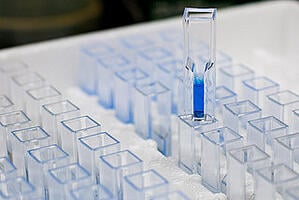 When conducting an experiment, it is essential to choose the correct protein assay.
When conducting an experiment, it is essential to choose the correct protein assay.
However, an assay that specifically determines the protein concentration across multiple samples does not exist.
To accommodate the most samples, scientists rely upon two main assay methods: the BCA assay and the Bradford assay.
The BCA Protein Assay
The bicinchoninic acid protein assay is a biochemical assay that determines the total concentration of protein solutions in 1 ml assays or micro-wells.
As one of the most commonly used protein assays, the BCA assay is highly sensitive and compatible with detergent-solubilized protein solutions and relies primarily on a two-step reaction process:
First, in a temperature-dependent reaction, the peptide bonds in the protein sample reduce Cu+ ions, from the copper solution to Cu2+, which is proportional to the amount of protein present in the solution.
Next, two molecules of bicinchoninic acid (BCA) chelate with both Cu+ ions form a purple-colored product that absorbs light at a wavelength of 562 nm. The wavelength is linear for increasing protein concentrations between the range of 0.2-2mg/ml.
The amount of protein in a solution can be quantified by measuring the absorption spectra with a spectrophotometer, comparing with protein solutions with known concentrations.
There are several advantages to utilizing a BCA assay. First, it provides more excellent protein-to-protein uniformity and produces a low variance in color change, even when different types of proteins are used. The BCA assay also exhibits extreme sensitivity and is compatible with a wide range of ionic and non-ionic detergents, protein concentrations, and extraneous materials.
The BCA assay possesses limitations, as it requires a prolonged inhibition time, which ranges anywhere from 30 minutes to 2 hours. To ensure the accuracy of results, scientists should simultaneously assay samples and protein samples. The presence of amino acids, reducing agents, and copper chelating agents also have the potential to interfere with results.
The Bradford Protein Assay
The Bradford protein assay, based on the dye-binding properties of Coomasie Blue, is a spectroscopic analytical procedure that measures the concentration of protein in a solution.
The method is suitable for rapid and straightforward estimation of protein concentration. The binding of protein results in the changing of color from red (an absorbance of 465 nm) to blue (an absorbance of 595 nm), which is proportional to protein concentration.
Apart from determining the protein content of cell fractions, the Bradford protein assay method is suitable for performing protein concentrations for gel electrophoresis and can be completed with as little as 0.5 µg protein.
The Bradford protein assay method is quick and easy to perform, but there are other advantages as well. Due to extreme sensitivity, it produces accurate results, detects a wide range of proteins from 1 to 20 µg. Also, the Bradford method does not require a spectrophotometer to measure the absorbance of the sample. The method is also compatible with most buffers, solvents, salts, reducing agents, and chelating agents.
However, there are also disadvantages, as the Bradford protein assay results in high protein-to-protein variation. The Coomassie dye is highly acidic and cannot be used for proteins with poor acid solubility. The method is incompatible with surfactants and highly sensitive to basic and aromatic amino acids, such as arginine and lysine.
Which Assay Method Should You Use?
Since a single protein assay method that is sensitive to all protein types does not exist, the success of your experiment relies upon specific factors.
You need to consider protein-to-protein uniformity, sample volume, the accuracy, speed, and convenience of the assay, and the availability of the required equipment.
Therefore, you should take the factors of your application into consideration when choosing between the BCA assay and Bradford protein assays.
Rely on G-Biosciences for Your BCA Assay Needs
G-Biosciences offers a variety of protein assay products for your experiments. To learn more, visit our website and place an order today.






